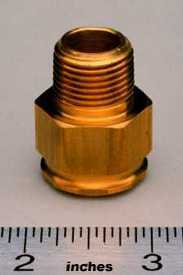 From a mechanical properties standpoint, the automotive transmission fitting shown here can be made from either Free-Cutting Brass or AISI 12Ll 4 leaded steel. Which metal is the more economical choice?
From a mechanical properties standpoint, the automotive transmission fitting shown here can be made from either Free-Cutting Brass or AISI 12Ll 4 leaded steel. Which metal is the more economical choice?
Assume that brass rod costs $1.08/lb; that leaded steel costs $0.42/lb; that brass turnings have a recycle value of $0.88/lb and steel turnings have none, and that screw machine time costs $35/h.
Costs of both brass and steel fluctuate with market conditions, but the assumptions made here are consistent with prices that have existed in recent years. There is no intent to imply that the prices assumed here are current; however, they reasonably represent the metals' relative market prices.
Screw machine operators look at parts in terms of their scrap ratio, i.e., the weight of turnings (scrap) produced divided by the total weight of raw material. Most screw machine products have scrap ratios between 50% and 75%; the ratio for the automotive fitting shown here is 71%. To make 1,000 of the fittings in leaded steel requires 290 lbs. (131.15 kg) of half-inch hex bar stock, of which 84 lbs. (38.1 kg) is converted to finished product and 206 lbs. (93.4 kg) remains as turnings. Free-Cutting Brass is eight percent denser than steel, so to make the same 1,000 pieces in brass consumes 314 lbs. (142.4 kg) of half-inch hex rod, 91 lbs. (41.3 kg) as product and 223 lbs. (101 kg) as turnings.
Raw material cost for 1,000 steel parts is 290 lb x $0.42/lb $121.80. No allowance is made for steel turnings since they have little or no value. Raw material cost for 1,000 brass parts is 314 lb x $1.08/lb = $339.12 minus a turnings allowance of 223 lb x $0.88/lb $142.88. Thus, the net raw material cost premium for brass in this example is approximately 17%, far less than the metals' off-the-shelf price would suggest. With steel, it takes 2.53 hours per l,000 pieces to produce the fitting on a standard multiple spindle screw machine. To account for tool changes, restocking, etc., machinists' estimates customarily include an efficiency factor (typically around 70% for steel, 80% for brass); therefore, the cost to machine 1,000 parts in steel is (2.53 h/M 0.70) x $35/h = $126.39. Brass parts only require 1.56 h/M machining time, and the corresponding costs are (1.56 h/M - 0.80) x $35/h = $68.06. The cost to produce the fitting in steel is therefore $121.80 + $126.39 = $248.1 9. The cost in brass is $142.88 + $68.06 = $210.94. As machined, the part costs $37.25/ M (15%) less in brass than in steel. These are actual production data generated by a Midwestern screw machine shop that has manufactured the fittings in both metals.
The savings don't end there. The steel fittings have to be coated to resist corrosion. Here are some representative coating costs for a selection of common protection systems:
| Zinc electroplate + chromate dip | $0.14/lb |
| Zinc/Iron | $0.35/lb |
| Cadmium electroplate + chromate dip | $0.27/lb |
| Zinc/Cobalt | $0.40/lb |
By using brass and eliminating the need for even the least expensive zinc + chromate coating, the fitting shown above costs 19.9% less than it would in steel.
